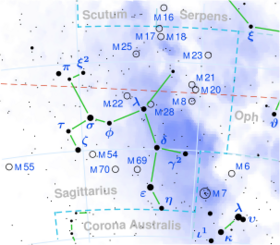Astronomy:HR 6801
| Observation data Equinox J2000.0]] (ICRS) | |
|---|---|
| Constellation | Sagittarius |
| Right ascension | 18h 11m 43.33342s[1] |
| Declination | −23° 42′ 04.4346″[1] |
| Apparent magnitude (V) | 4.96[2] |
| Characteristics | |
| Spectral type | K0III[3] |
| U−B color index | +0.90[4] |
| B−V color index | +1.05[4] |
| Astrometry | |
| Radial velocity (Rv) | +5.71±0.20[1] km/s |
| Proper motion (μ) | RA: +9.337[1] mas/yr Dec.: −31.999[1] mas/yr |
| Parallax (π) | 12.6303 ± 0.2449[1] mas |
| Distance | 258 ± 5 ly (79 ± 2 pc) |
| Absolute magnitude (MV) | 0.49[2] |
| Details | |
| Mass | 2.24[5] M☉ |
| Radius | 13.35+0.14 −0.92[1] R☉ |
| Luminosity | 78.6±1.7[1] L☉ |
| Surface gravity (log g) | 2.65[5] cgs |
| Temperature | 4,705+171 −25[1] K |
| Metallicity [Fe/H] | 0.00[5] dex |
| Rotational velocity (v sin i) | 1.6[6] km/s |
| Other designations | |
| Database references | |
| SIMBAD | data |
HR 6801 is a single[8] star in the southern zodiac constellation of Sagittarius. It was designated as 1 Sagittarii by Flamsteed, but is now often referred to as 11 Sagittarii. Flamsteed's 11 Sgr actually refers to a different, much fainter star.[9] The object is orange in hue and is visible to the naked eye as a faint point of light with an apparent visual magnitude of 4.96.[2] The distance to this star is approximately 258 light years based on stellar parallax, and it is drifting further away with a radial velocity of +6 km/s.[1]
This is an aging giant star with a stellar classification of K0III.[10] It is a red clump giant,[11] which indicates it is on the horizontal branch and is generating energy through helium fusion at its core. The star has 2.24[5] times the mass of the Sun and has expanded to 13.4 times the Sun's radius. It is radiating 79 times the luminosity of the Sun from its photosphere at an effective temperature of 4,705 K.[1]
A faint visual companion, component B, has magnitude 11.51 and an angular separation of 43.7″.[12]
References
- ↑ 1.00 1.01 1.02 1.03 1.04 1.05 1.06 1.07 1.08 1.09 1.10 Brown, A. G. A. (August 2018). "Gaia Data Release 2: Summary of the contents and survey properties". Astronomy & Astrophysics 616: A1. doi:10.1051/0004-6361/201833051. Bibcode: 2018A&A...616A...1G. Gaia DR2 record for this source at VizieR.
- ↑ 2.0 2.1 2.2 Anderson, E.; Francis, Ch. (2012). "XHIP: An extended hipparcos compilation". Astronomy Letters 38 (5): 331. doi:10.1134/S1063773712050015. Bibcode: 2012AstL...38..331A.
- ↑ Houk, Nancy; Smith-Moore, M. (1978). Michigan catalogue of two-dimensional spectral types for the HD stars. 4. Ann Arbor: Dept. of Astronomy, University of Michigan. Bibcode: 1988mcts.book.....H.
- ↑ 4.0 4.1 Mermilliod, J. C. (2006). "VizieR Online Data Catalog: Homogeneous Means in the UBV System (Mermilliod 1991)". VizieR On-line Data Catalog: II/168. Originally Published in: Institut d'Astronomie 2168. Bibcode: 2006yCat.2168....0M.
- ↑ 5.0 5.1 5.2 5.3 Liu, Y. J. et al. (2007). "The abundances of nearby red clump giants". Monthly Notices of the Royal Astronomical Society 382 (2): 553. doi:10.1111/j.1365-2966.2007.11852.x. Bibcode: 2007MNRAS.382..553L.
- ↑ De Medeiros, J. R. et al. (2014). "A catalog of rotational and radial velocities for evolved stars". Astronomy & Astrophysics 561: A126. doi:10.1051/0004-6361/201220762. Bibcode: 2014A&A...561A.126D.
- ↑ "11 Sgr". SIMBAD. Centre de données astronomiques de Strasbourg. http://simbad.u-strasbg.fr/simbad/sim-basic?Ident=11+Sgr.
- ↑ Eggleton, P. P.; Tokovinin, A. A. (September 2008), "A catalogue of multiplicity among bright stellar systems", Monthly Notices of the Royal Astronomical Society 389 (2): 869–879, doi:10.1111/j.1365-2966.2008.13596.x, Bibcode: 2008MNRAS.389..869E.
- ↑ Wagman, M. (August 1987). "Flamsteed's Missing Stars". Journal for the History of Astronomy 18 (3): 212. doi:10.1177/002182868701800305. Bibcode: 1987JHA....18..209W.
- ↑ Hoffleit, D.; Warren, W. H. (1995). "Bright Star Catalogue". VizieR On-line Data Catalog: V/50. Originally Published in: 1964BS....C......0H 5050. Bibcode: 1995yCat.5050....0H.
- ↑ Alves, David R. (August 2000). "K-Band Calibration of the Red Clump Luminosity". The Astrophysical Journal 539 (2): 732–741. doi:10.1086/309278. Bibcode: 2000ApJ...539..732A.
- ↑ Mason, Brian D. et al. (2001). "The 2001 US Naval Observatory Double Star CD-ROM. I. The Washington Double Star Catalog". The Astronomical Journal 122 (6): 3466. doi:10.1086/323920. Bibcode: 2001AJ....122.3466M.
 |


